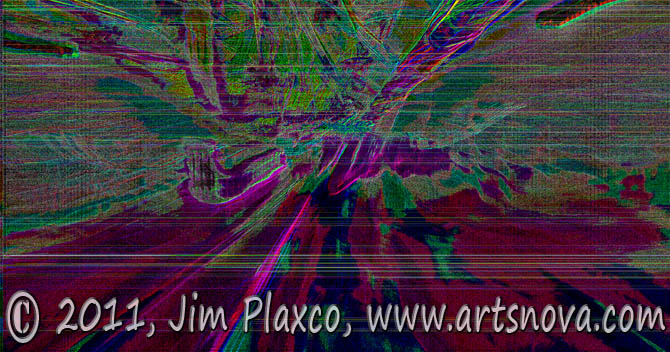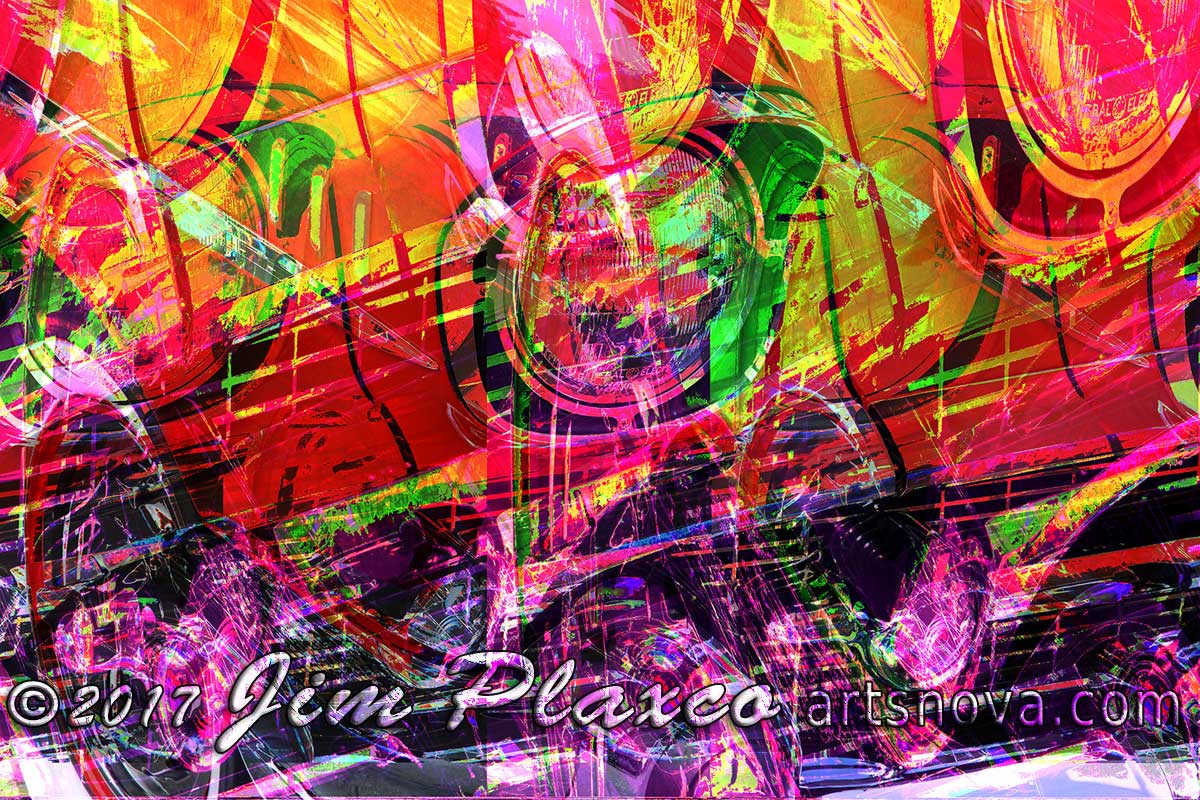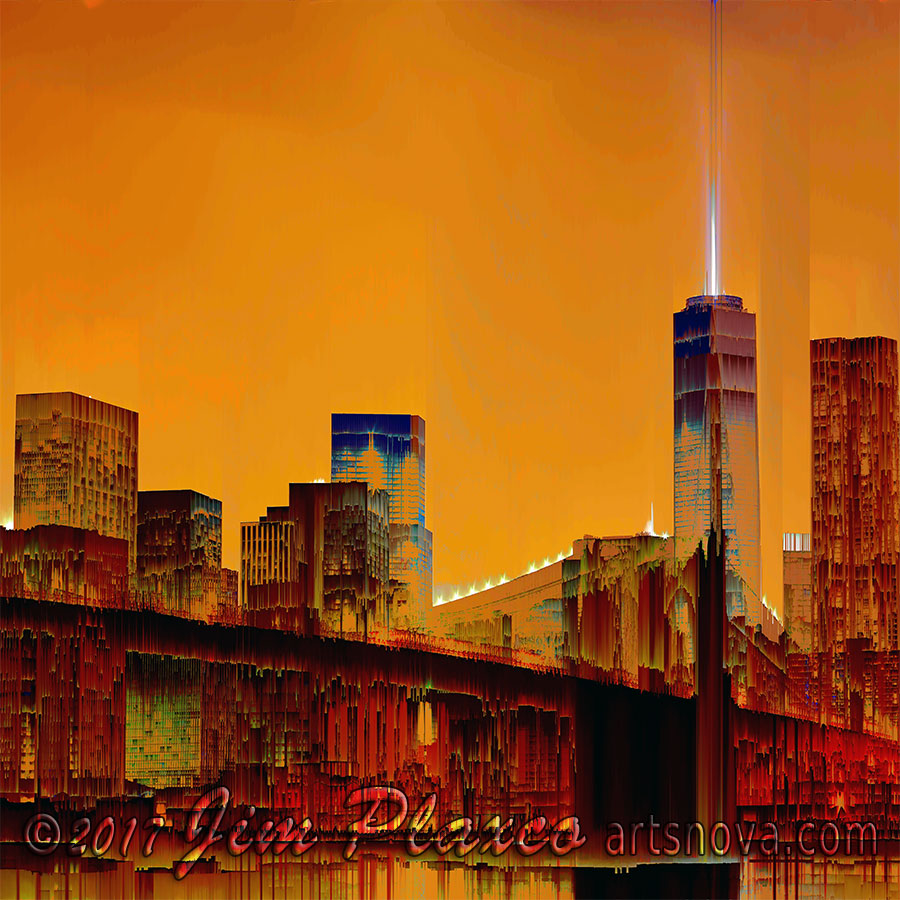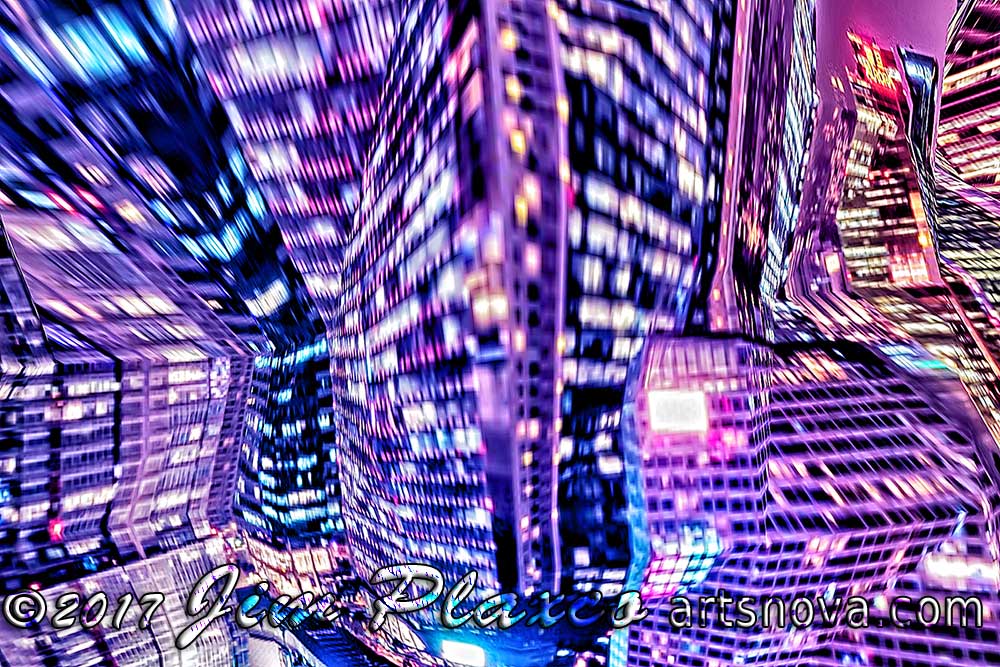Glitch Art or Not Glitch Art?
By Jim Plaxco, 10/09/2017
Take a look at the photograph above. Do you believe me when I say it qualifies as an example of glitch art? Most glitch artists would say yes. Quite clearly there is something wrong with the photograph but is that sufficient to warrant categorizing it as a work of glitch art?
Initially glitch art was rather narrowly defined as being art created by accident rather than by deliberate design - mind you that many of the accidents were deliberate in nature. A personal example of glitch by accident is Night Glitch shown below.

I don't know how or when it happened but data in the file for an abstract photograph I had taken became corrupted and the image above was the surprise that greeted me when I opened that file in a photo viewer. The concept of glitch allowed me to capitalize on my corrupted file.
Look up the definition of the word glitch and you will see that it means a defect or malfunction or error or problem in a machine or a system or a plan. Turning to Wikipedia, glitch art is defined as:
the practice of using digital or analog errors for aesthetic purposes by either corrupting digital data or physically manipulating electronic devices.
So Night Glitch clearly qualifies as an example of glitch art.
As time has passed, the techniques used to create glitch art have expanded. So too has the definition of what constitutes glitch art. In particular electronic artists, aka new media artists, aka digital artists have now formalized the creation of glitch art. By formalized, I refer to the introduction of deliberate techniques like databending, datamoshing, and other forms of algorithmic manipulation like pixel sorting.
Databending, for example, is about editing the information contained within the digital file that is used to define an image or photograph. An example of such a change is simply using a binary file editor (hex editor) to manually edit the file's data values. Alternatively, I could write a program that randomly changes the bits and bytes in a file. There is nothing new or novel about this - digital artists have long made use of random number functions as a proxy for creativity in the creation of digital art.
Another popular databending technique is to use software like Audacity, a program created for editing audio files, to manipulate an image file's data. Audacity algorithms created to produce a desired effect when processing an audio file - their intended target - will produce quite another effect when applied to an image file. An example of this can be seen in one of my own artworks. I created Classic Chevy Auto Glitch by feeding a photograph into Audacity and running several audio filters on the file. In the end I quite like the effect I was able to achieve.

Datamoshing is yet another term which is really no different than databending - the deliberate corruption of the data that defines an image or a video. Whether you call it databending or datamoshing, both methods when considered programmatically represent the same methodology.
Another newer example of what is now dubbed glitch art is the algorithmic process known as pixel sorting - which has nothing to do with chance or accident and everything to do with standard image processing. With pixel sorting, one is simply sorting rows and columns of pixels, either in full or in part, according to the numeric value of one of the numbers that is used to describe the pixel's color. Pixel values that can be used for sorting include the numbers used to describe the amount of red, green, blue, brightness, hue, saturation, or value (a brightness alternative) that is present in the pixel. An example of my own work with pixel sorting is Brooklyn Bridge New York City. To create this work, I used my own variation of the pixel sorting method in order to achieve more control over the process.

For my part, while I am willing to associate the term glitch with images produced by the use of a pixel sorting algorithm, it does strike me as not truly adhering to the original intent of the term. After all, there is nothing accidental about the process.
Taking a broader perspective, there is now also a strong case to be made that glitch art is a subset of generative art - one of my favorite areas of artistic exploration. The reasoning is this: given that generative art is broadly defined as artwork that has been created by a system that has been designed by the artist, then glitch art created using a system designed by the artist is clearly to be found within the borders of the generative art world.
Clearly, in the ever changning world of digital art, defining boundaries for terms that are meant to categorize art can be a challenge. This is particularly true when it comes to glitch art, especially when there are Adobe Photoshop actions and filters whose purpose is to give a photograph or artwork a glitched appearance - which to me makes glitching a meaningless label.
When considering whether or not a claimed work of glitch is truly glitch, I would ask people to consider the definition of algorist, a term coined by Jean-Pierre Hébert at the 1995 SIGGRAPH with respect to algorithmic art. Appropriately enough the definition is given in the form of an algorithm:
if (creation && object of art && algorithm && one's own algorithm) {
include * an algorist *
} elseif (!creation || !object of art || !algorithm || !one's own algorithm) {
exclude * not an algorist *
}
What the definition says is that if you want to be an algorist (one who creates algorithmic art), then you must be the creator of the system that is being used to create the art in question. The analogy to glitch art should be clear. To truly be a glitch artist, then the artist must be the creator of the system or the machine that is used to create their glitch art. Simply running a Photoshop action against a photograph - or using someone else's program - just doesn't cut it.
So, is Glitch City Night a work of glitch art?
For that matter, does Glitch City Night qualify as a work of generative art? Given that I created the system, a program that implements an image processing algorithm to distort the source image, and that I interacted with the system to achieve the desired effect, this artwork does qualify as a work of generative art. But glitch art? There were no accidents or errors in the process. But then there are no accidents or errors when using a pixel sorting algorithm to process an image. So given the vagueness of the definition, I could argue that the art used to illustrate this article is indeed a work of glitch art.
Related Glitch Articles:
- Digital Art and Unintended Consequences
- Recursion Glitch Art
- Painting with Sound and Glitch Art
- Creating Stepping Through Time Abstract Art
- Glitch Art: Errors in the name of Art Presentation
“Digital is not here to put an end to anything. Rather it is here to expand all things, to combine and to make more things attainable. For the artist, it is the edgiest work of all; the biggest, most exciting challenge in a long history of the synthesis between technology and hand and mind and heart.”
J.D. Jarvis~Artist, DFAS(Digital Fine Arts Studio)-NM Member
